The Witcher 2: Assassins of Kings is a game that, on its heart, doesn't actually show Geralt beating up monsters a whole ton. I mean, the underlying concept of Geralt of Rivia is still a monster-hunter shunned by the world thanks to his mutated magic abilities, but the monster-hunting takes a significant back-seat in Witcher 2 because as the subtitle implies, the significant focus of the main plot is a mysterious man going around killing kings and destabilizing the country. It's actually pretty well done and I was extremely invested in the storyline of the game. There are varied opinions about this game and I think it's often viewed as the weakest game among the Witcher trilogy... but I dunno, I really enjoyed my time with Witcher 2. Sure, the sequel game perfected the gameplay and stuff, but I did really had a good time playing through Witcher 2.
It's a neat jumping-in point for me to talk about the monsters of the Witcher series, though, because Assassins of Kings, while not without its monsters, definitely had them take a back-seat and end up being more obstacles and side-quests instead of being part of the main story.
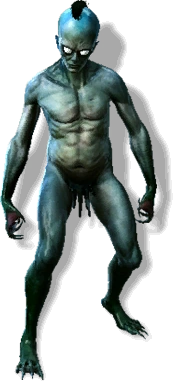
Drowner
We'll start off with the 'common' enemies first, ones that are pretty weak and respawn after a while. The Witcher 2 has a pretty extensive amount of words written for its bestiaries, but the only way to unlock those is by finding specific in-game books and reading them, which is a bit of a rather convoluted way to do it. Realistic, perhaps, but considering the fact that the game automatically updates everything like quests and character bios as you progress in the game, I'm so happy that Witcher 3 did away with it and basically have you unlock the monster bestiary entry after killing a representative of the species. Thank goodness for online wikis and stuff, which archive all of the bestiary entries for the monsters.
Drowners are one of the staples of the video game series, appearing in all three games and loosely based on the Utopiec in the novels, itself based on a monster of the same name from Slavic mythology. Both the myhtological utopiec (from what I can find online, anyway) and the Drowner are basically restless spirits of the dead who drowned, rising up from their graves to haunt the living and basically drag them down to drown with them. The Drowners are not that overly complex as enemies in terms of lore or design, and in the Witcher series, they are classified as a 'Necrophage', which... basically means zombies that eat the dead, I guess. As their name implies, Drowners are always found near rivers, lakes and swamps. They're pretty simple to wrap your heads around, rising from a specific brutal death and being basically gaunt blue-skinned ambulatory corpses. In the first Witcher game they had fishmen gills, but I suppose they did away with it in the second and third games to match the actual mythological creature a bit better. Most of these monsters are absolutely no threat to Geralt (since he's a mutant with enhanced strength, magical items and spellcasting abilities) when it's a one-on-one battle, but they can be more than a nuisance when there are a lot of them. As you progress in the game, stronger Drowners, called "Drowned Dead", will show up with them as elite enemies. Not a whole ton to say here, but they do set the basic mood of most of the monsters in the Witcher series, which really have a lot of classic folklore vibe to them.
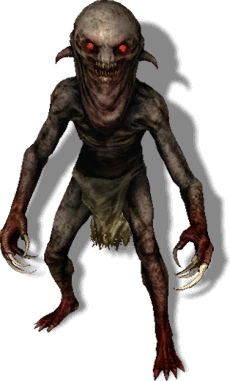
Nekker
Not being drawn from any creature in the novels specifically, the Nekker seems to draw its inspiration or name from a Germanic/Scandinavian mythological creature called the Neck, known in various different cultures as the Näck, Nøkken, Nixie, Nekker, Nikker or various different variations depending on the culture. But in all versions of the mythological Neck, they have always been water spirits or mermaid/mermen of a sort, so the Witcher games' Nekker seems to just draw nothing but the name. The Nekkers make their debut in Witcher 2 and are basically the game's most common monsters, although they show up mostly in caves and forests, or in little anthill-like cave-mounds that the game asks you to blow up with makeshift grenades. They're... they're just ugly ghoul-like humanoids with glowing red eyes and sharp claws. Looking closely at the model, they have a huge, bulging 'neck' that is where their names come from, but most of the time you fight Nekkers in Witcher 2 and Witcher 3, they move so quickly and in the dark that you just see vague angry humanoids with spooky red eyes.
The Nekkers' origins are never explained, and in Witcher 2 are classified as 'other'. Witcher 3 would reclassify them as 'ogroids', meaning that they're just humanoid monsters akin to trolls and ogres, so I guess they're the Witcher-world's equivalent to goblins? The Nekker is always found moving around in small tribes, and Geralt never really encounters one. They burst out of the ground and basically try to overwhelm Geralt with numbers. They're very basic enemies, just mostly threatening thanks to their number and habitat. Like the Drowners, you eventually meet stronger Nekker variants -- the Nekker Warrior -- as you progress through the game. You do get the feeling that while Geralt of Rivia is a mighty mutant spellcaster that can slash through a nest of them if he's doing all the Witcher skills properly, they're still enough of a threat if he's sloppy and definitely a threat to just some random peasant without a silver sword.
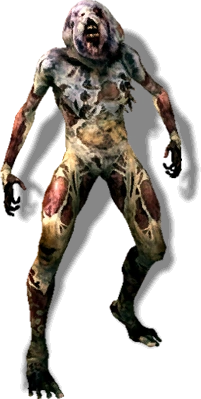
Rotfiend
The Drowners are kinda-zombies, but the Rotfiends are definitely a bit of a stereotypical video game zombie. Flayed body, a mutated head, and they explode upon death? Yep, this wouldn't look out of place in Left For Dead or Resident Evil or something. I do like the design of the Rotfiend, though, with their huge, bulbous heads that seemingly have covered all its features other than its angry zombie mouth. Their names are pretty descriptive, too, and apparently they multiplied a lot after all of the wars that have ravaged the lands. They're also classified as Necrophages, which means that they feed on corpses and will happily turn humans into corpses for them to feed on. I do like the detail that the game goes into talking about how Rotfiends can dig into graves and munch on the dead bodies there (and presumably multiply?) and the only sure way to cut off a Rotfiend infestation is to burn dead bodies. They're ultimately not that dangerous, though, although I've always held them to be a bit more impressive than the Drowners and Nekkers.
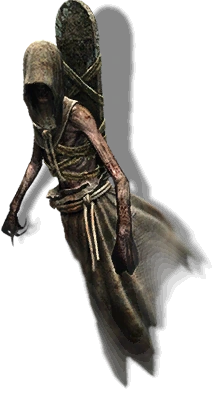
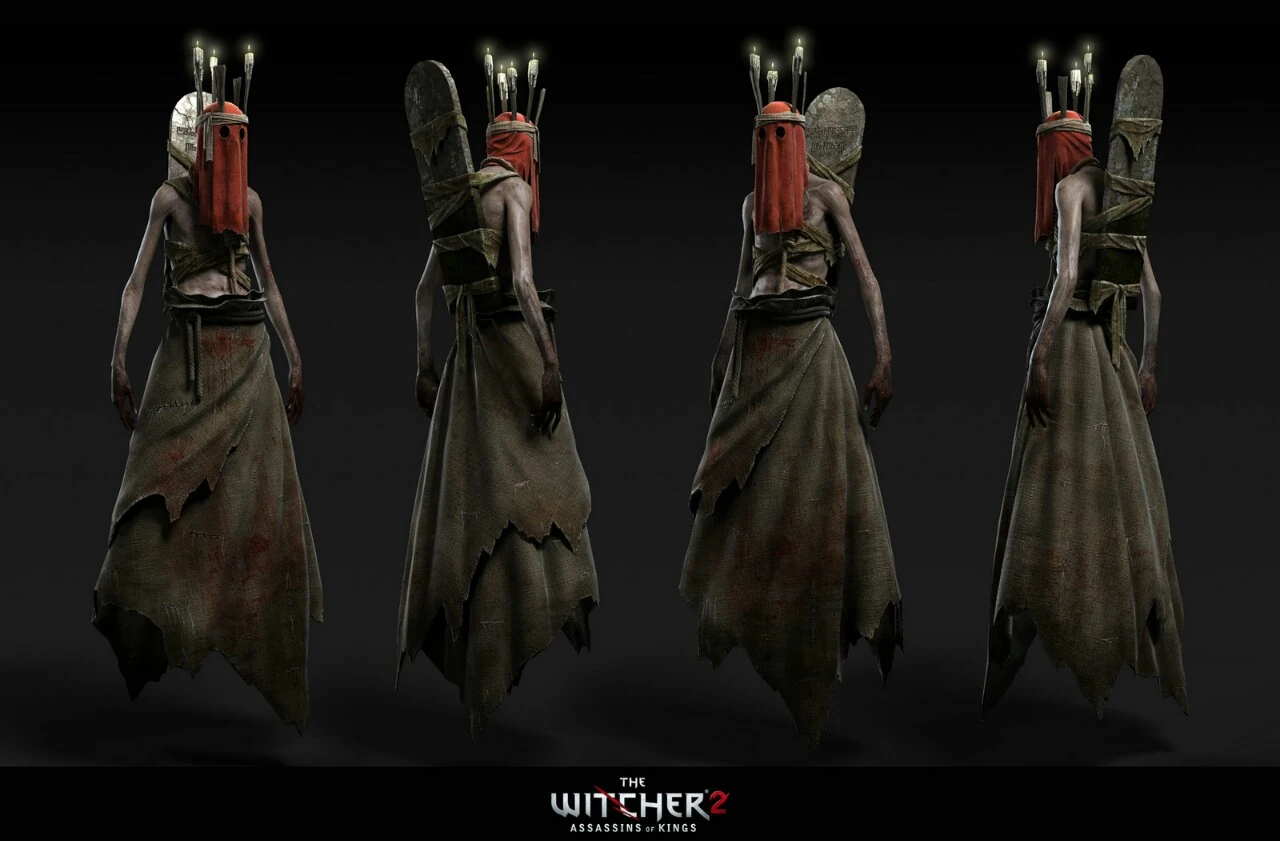
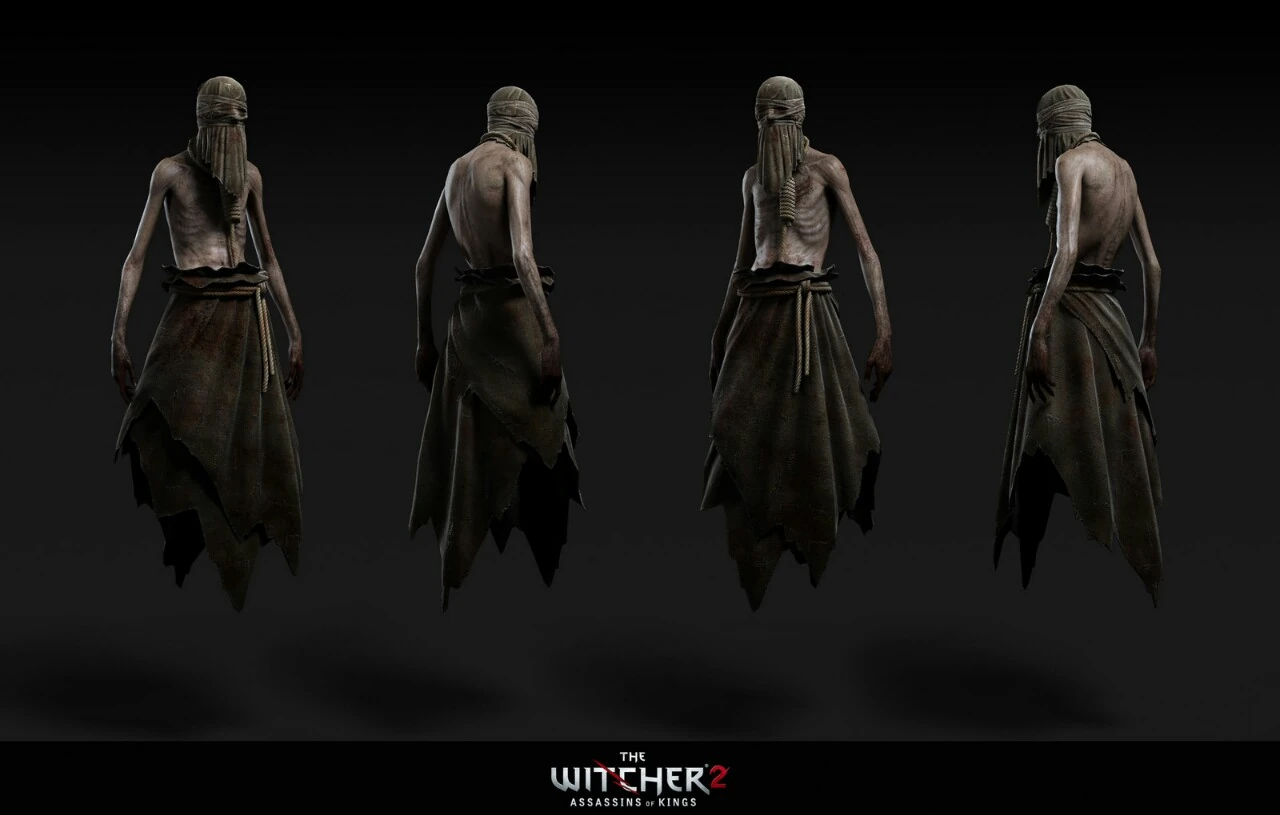
Wraith
There are a bit more of these intangible ghosts and specters in the first and third game, but in Witcher 2, the primary spooky incorporeal enemy is the Wraith. Three different models exist, but they're always consistent in that they're floating spirits with covered faces, tattered clothes, and two of the three models have what I think is their own gravestone lashed onto their backs -- which I thought is such a cool little addition that doesn't look like much, but makes Witcher's wraiths feel a fair bit more unique than the many, many spooky ghosts that are basically obligatory enemies in a fantasy setting.
In Witcher lore, the wraiths are created from people who die suddenly, leaving the world with a lot of tasks left unfinished and become ghosts obsessed with fulfilling their own aims but are basically stuck near the place of their demise. Most of the Wraiths in the game are unable to communicate with the living, but Chapter 2 of Witcher 2 has this huge event where the site of a particularly bloody battlefield ends up having all of its dead reanimated into wraiths who are basically reliving the battle that led to their deaths over and over again, and Geralt has to figure out how to appease some of these spirits. Like most video game ghosts, Wraiths alternate between being tangible and intangible and you need to time your attacks, although Geralt's Signs (essentially his magic spells) can usually stun them regardless of whether they're in the intangible phase or not. Ultimately kind of boring, but it's at least not another zombie.
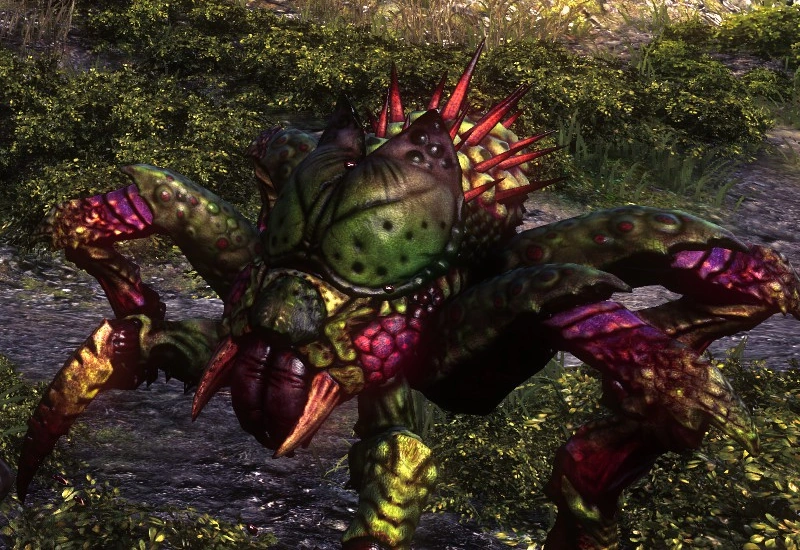
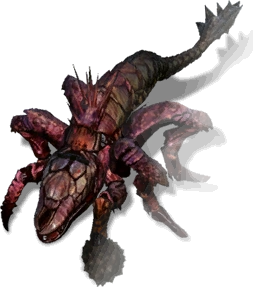
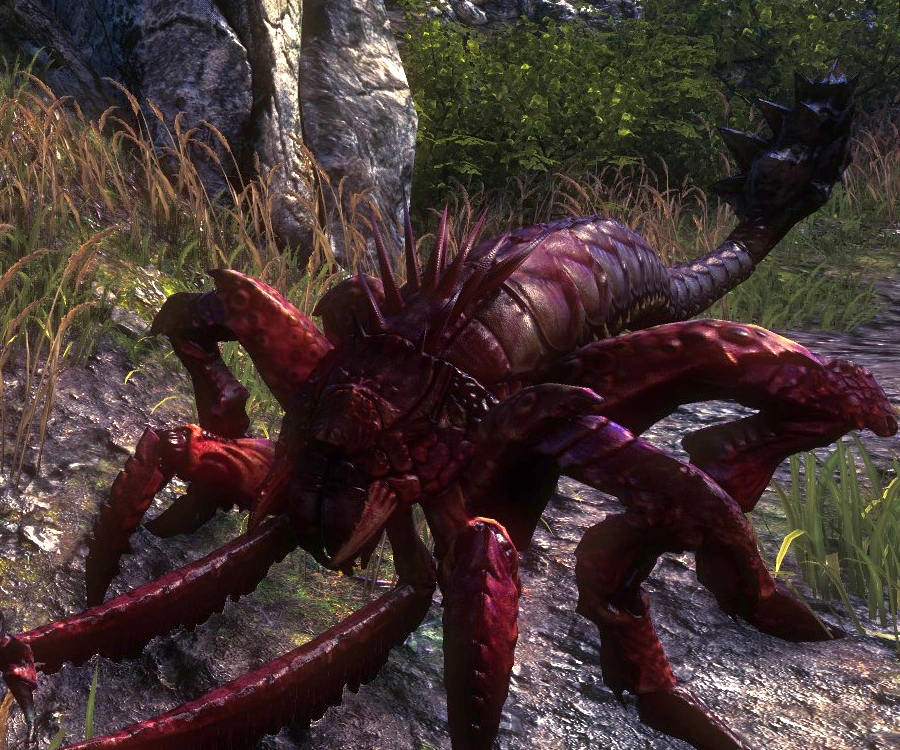
Endrega
Easily hands-down my favourite creature in these games, although anyone who's read my monster reviews know that I have a soft spot for anything vaguely insect-based. The Witcher wiki tells us that the Endrega are apparently based on the Endriago, a monster from the Spanish novel Amadis de Gaula, which is described as a chimera-esque creature born out of incest. Witcher's endrega, viewed through that lens, makes a bit more sense. It's really a bug monster, with six chitinous legs and living in forests and working in giant hives, but its head looks more like a crocodile (if a crocodile's body is covered with chitin) but it opens sideways like an insect; and its tail is structured more like a lizard's but the Endrega will rear it up like a scorpion's. Realizing what their inspiration was gives me a bit more insight to what the logic behind this creature's design is, although whatever the case I'm sure I still really like the endrega as these creepy lizard-bugs.
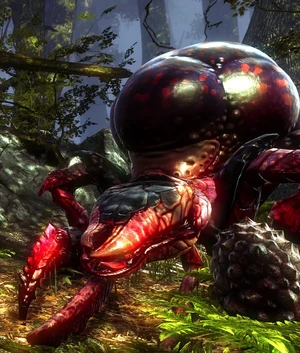 Unlike the Nekker or the Drowner, the Endrega's various forms receive unique models. The regular Endrega looks more like some sort of mutant giant spider, having the body structure but is a lot more colourful and has a bunch of wacky extra spikes and colours slapped onto it. The Endrega Guard (the most common type) is the one that looks most like a crocodile-spider. The Endrega Warrior looks basically identical to the Guard, save for the fact that it's got two extra tusk-like protrusions. And their big boss monster, the Endrega Queen, has the typical ballooned abdomen that fictional bug queens are basically obligated to have. Those giant termite queens are really seeped into the public consciousness, huh?
Unlike the Nekker or the Drowner, the Endrega's various forms receive unique models. The regular Endrega looks more like some sort of mutant giant spider, having the body structure but is a lot more colourful and has a bunch of wacky extra spikes and colours slapped onto it. The Endrega Guard (the most common type) is the one that looks most like a crocodile-spider. The Endrega Warrior looks basically identical to the Guard, save for the fact that it's got two extra tusk-like protrusions. And their big boss monster, the Endrega Queen, has the typical ballooned abdomen that fictional bug queens are basically obligated to have. Those giant termite queens are really seeped into the public consciousness, huh?Again, while very loosely based on the hive structure of an ant or something, I really do appreciate that the Endrega's various members look so different. The Guard and the Warrior are easily my favourite since they are the ones that look completely unique unlike the weakest Endrega or the Queen, who are merely cool-looking bug monsters. And I do say 'merely', but bug monsters are really cool. It's just that the twist they took with the Endrega Guard by making it a reptile-arhtropod fusion really ends up working quite well. Also, if they're not weird enough, they lay their egg sacs in giant venus flytrap structures. Very weird, and very cool. For the most part, you only ever fight the weaker Endregas, but it's only when these egg sacs are threatened or defaced that the Endrega Queen will emerge from her lair to fight you. Not a whole ton to say here, as more common enemies you basically have to hack'n'slash, dodge and not die when you fight them.
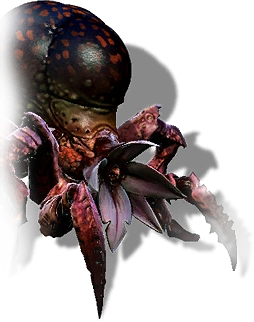
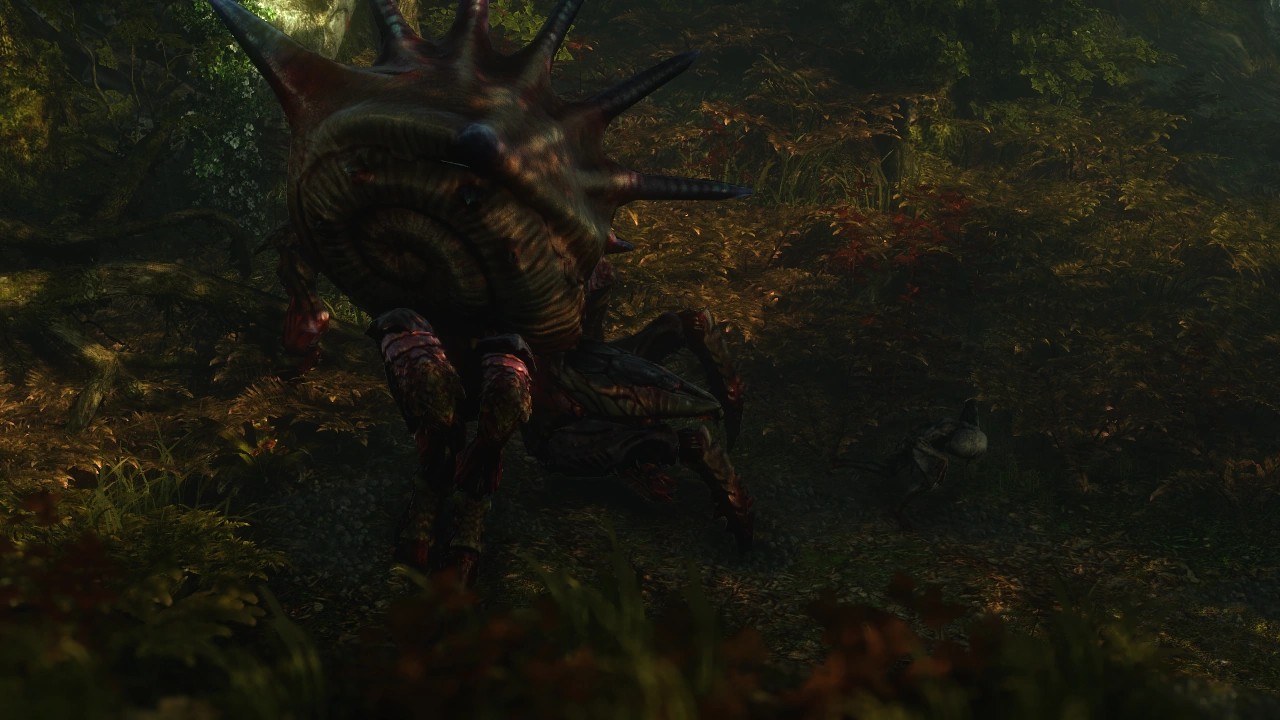
Arachas
The Arachas is the first of the... 'mini-bosses', I guess? There's a finite amount of these in the overworld, and I don't think they re-spawn, but they're not the focal part of any main quest. In the storyline of Witcher 2, you only really have to fight one of this if you're basically blazing through just the main quest, although they do show up as potential encounters later on. Another one that to my knowledge is completely original ('Arachas' seems to just be a twist on 'arachnid') to the games, the Arachas is less of a giant bug like the Endrega, and more of a... bizarre bug-like monster. I've fought and killed a bunch of these in the game, looked at the concept arts and even then every time I look at this thing I find something cool about it. Sure, it probably shares a lot of the same assets as the Endrega Queen with its bent spider legs and the way it moves, but man, the fact that for some reason the Aracahas scuttles around with what's essentially a giant hermit crab shell? The versions we fight in Witcher 2 never quite got as varied as the concept art, but there's like a fun, very specific style they were going for. Some of the Arachas have like bagworm-style giant pinecones on their back, some have huge fungus ball like growths... and they also have spider-like faces that open up into a giant flower-like mouth. It's a giant crab-spider-flower creature, and I love it. The game still classifies this as an 'insectoid' like the Endrega, but I do like that the insect monsters in Witcher have this bizarre fusion animal vibe to them.
The first time you actually see one is in a cutscene when one of the main characters, Iorveth, lobs a poor hapless Nekker to feed an Arachas he's basically tamed to guard one of his bases. I thought that was cool as hell. The Arachas is described by Geralt's bestiary as a massive creature that essentially lone hunters that rule over a segment of the forest that is its territory, and it's noted that the Arachas's armour is so strong that attacking it from the front is folly, and you have to side-step its charges to strike it from the sides or back. Of course, most of the time you fight the Arachas in pretty narrow quarters, making this a bit problematic. Pretty cool bug monster.
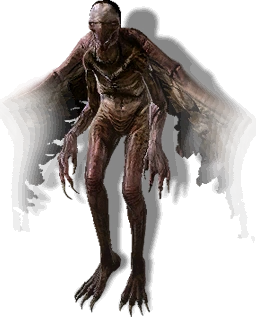
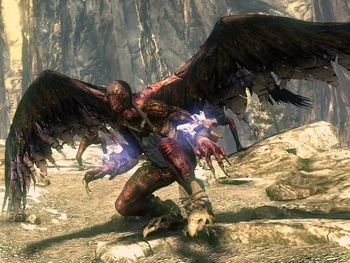
Harpy
Appearing in the second chapter, which takes place in a bit of a combination of a mountainous region with some foresty parts, the harpies are the common enemies there, giving an extra layer of complication because unlike all of the other enemies you've faced before, these bird-women can fly. They're pretty nasty looking, and the team behind Witcher really like to take gross, flabby, half-flayed human bodies to add to the grossness factor of their monsters if the Nekker, Drowner and Harpy are anything to go by. Harpies are pretty standard fantasy monster fare, they're bird-women that attack, maim and steal from humans. These are the 'wings sprout out from the back' variant as opposed to some depictions of the harpy that have wings instead of hands. In practice, being common enemies, the Harpy's ability to fly doesn't really matter since they need to come close to you to attack anyway, and sometimes they land and scuttle on the ground like a bat.
I really don't have a whole ton to say here, although I really do like the fact that they gave the harpy a very creepy-looking skeletal bird-face. The stronger Harpy variant, the Erynia, has weird glowing bracelets, but I didn't notice until looking at screenshots that the Erynia, instead of having beady bird eyes, had just a mass of scars atop her beak. Spooky! She also has Harpy-skull boots, which is a lot more goofy than scary. Apparently, according to the bestiary, those crystals are apparently 'stolen dreams', which I don't think comes into play in the actual game's story, but still neat.
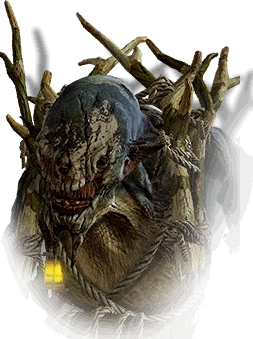
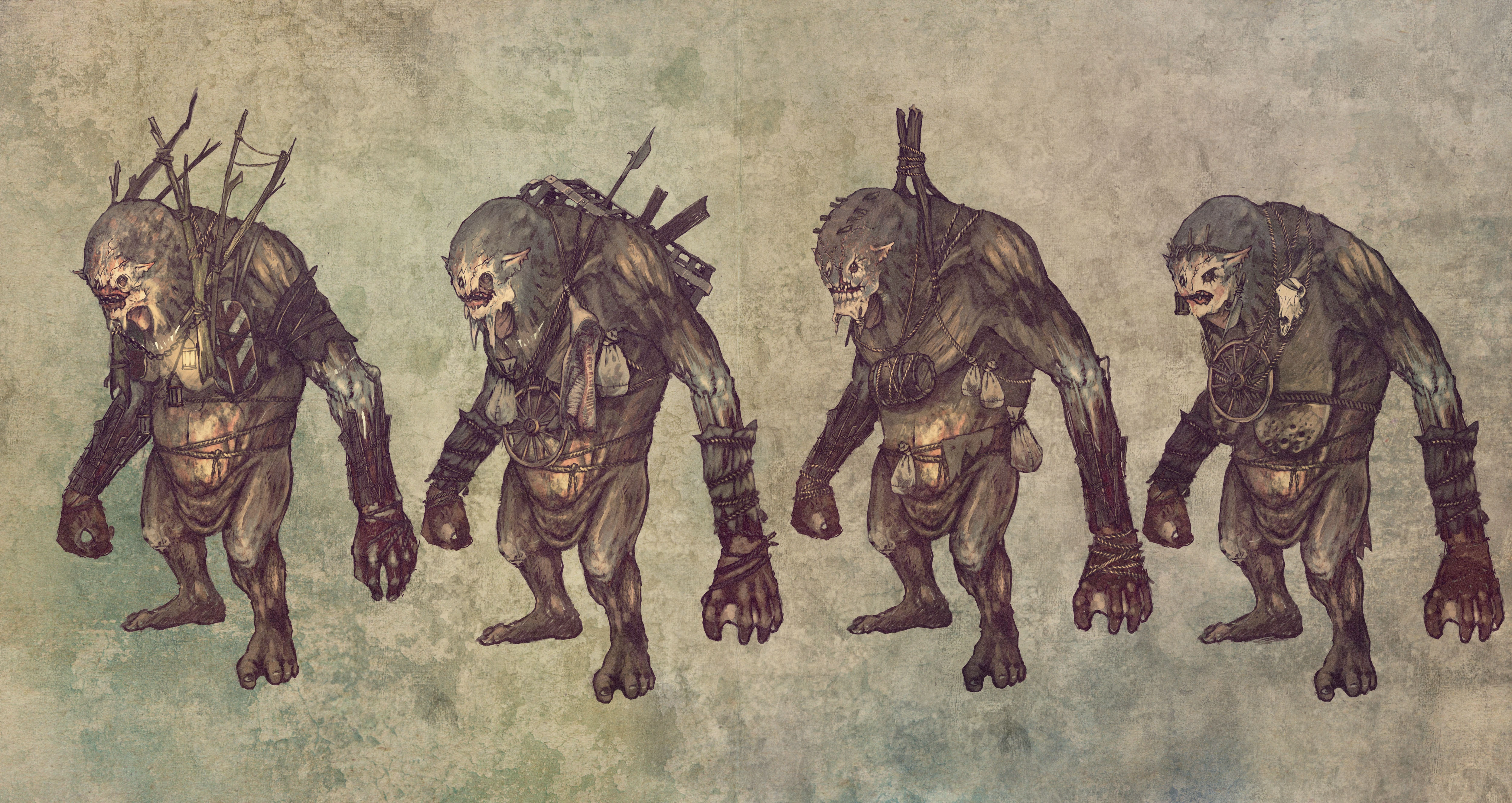
Troll
Oh man, I love the trolls. In essence they are still the archetypal European-style trolls. Huge, brutish, ugly humanoid beings that are dumb and destructive. At least one of the trolls you encounter in Witcher 2 is also a huge creature that guards a bridge (which I know for a fact is a nod to a fun line in The Last Wish novel). And yet... and yet in a game whose whole concept is that of a monster-hunter, at least in the novels there is a clear line that Geralt draws where, unless it's impossible otherwise, he's not going to assume that any sentient monster is the sort of 'kill or be killed'. And in Witcher 2, it's the trolls that end up making the player really explore this. And hoo boy, the trolls are ugly. They really succeeded in making the trolls look like utterly grotesque caricatures of humans, having absolutely fucked-up face that's missing flesh, particularly around the mouth, making those visible gums and teeth look extra creepy.
But the trolls in the game? They are brutish, they are dumb, they are perhaps easy to threaten violence... but three of the four trolls you meet in Witcher 2 are actually just trolls who want to be left alone, or are willing to negotiate payment or simply just... well, talking to them to pass through their territory. One of them is even just rampaging because he was drunk after losing his mate. That is really great! One of my pet peeves in any sort of fantasy setting is the existence of "always evil" sentient races. According to Geralt's bestiary, apparently the trolls in-universe are thought to be a lot more impressive than they actually are, with many legends thinking that they're born of earth and made of rock and get petrified into stone under sunlight. But they're just, well, huge people of flesh that simply are perhaps just a bit too primitive. It's interesting to note that trolls are also noted to be particularly susceptible to poisons, because they have such a fast metabolism that the poison is quickly spread across its body. That's a very interesting explanation, game, I love it.
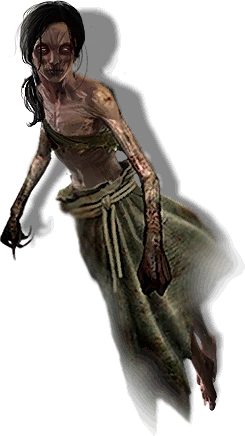
Bruxa
The Bruxa (taken from a type of Portuguese vampire) is an interesting enemy in that, at least in the path I took, I only met her at the conclusion of a particularly interesting little side-quest, and for the longest time I thought that the Bruxa is kind of this special, super-powerful enemy. A Bruxa also feature prominently in one of the stories in The Last Wish anthology, and a significant part of that story is Geralt mistaking her as a similar but less dangerous creature. Turns out that I just missed the other appearances of the Bruxa in the game, or maybe passed them off as wraiths. The Bruxa is described by the game's bestiary as a 'post-Conjunction creature', which means that, to put it in D&D terms, she's an extra-planar creature from another plane of existence. Normally appearing as a beautiful woman, her true form is a demonic vampire, and she fills in that vampire trope of seducing and manipulating her victim to essentially be her source of sustenance.
In this game, in the 'Last Sisters' sidequest, the Bruxa is portrayed a bit differently, although I think it's purposely left ambiguous whether the Bruxa you fought is merely a particularly powerful wraith, or a much more terrible being masquerading as the ghost of the NPC's dead sister. I felt like that was pretty awesome, and I do like the huge moment where Geralt realizes he's not just dealing with a boring old wraith. In the Bruxa's other appearances in the game series, they're basically just powerful undead women with some sense-debilitating screeches. Particularly in the first and third games, they run around as naked, blood-covered monster-women.
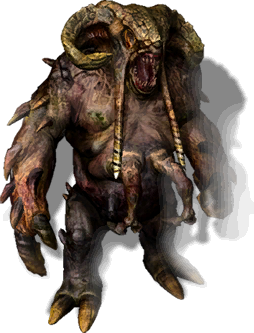
Bullvore
Classified as a Necrophage and probably the largest and most badass of them in Witcher 2, the Bullvore shows up a couple of times in the game summoned by evil sorcerers and the like to fight you. I personally never had too much trouble with them, although they sure look gross as hell. The head of a demonic bull, giant muscles and the whole 'zombie minotaur' bit is neat, although huge zombie monsters aren't especially novel in fantasy RPG video games. Those two teeny-tiny creepy hands jutting out of the Bullvore's belly is creepy, though!
It's interesting that the bestiary then describes the Bullvore as 'like a poet in that it is an individualist', because these Bullvores will only live as the only Bullvore in its lair, although it rules over Rotfiends and Nekkers, and often kills one of them in like a show of strength... but in a fanciful manner. Which makes it interesting. Sure, the Nekkers are implied to be a bit more intelligent than mere beasts, so them following a Bullvore's commands makes sense, but aren't the Rotfiends just mindless zombies? Eh. The Bullvore itself is ultimately not that interesting to fight. It is tough, hits pretty hard and has a gross acid attack, but ultimately is just a HP tank.
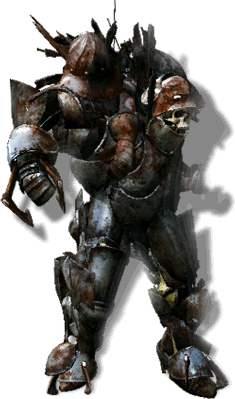
Draugir
The huge part of Chapter 2 involves you going through a battlefield where its dead has been turned into undead wraiths forced to fight each other for eternity, which isn't good for whichever side Geralt found himself in. And among the regular wraiths we have these Draugirs, taken, of course, from Norse's Draugr. These Draugir are less undead spirits and more a representations of war and the general violence inherent in war itself, being a bunch of remnants of corpses, armour and weapons that pull itself together into a vague resemblance of a humanoid shape to shamble into battle, usually summoned by their Draug master (who is a boss, and we'll cover that below). That's a very cool concept, and I've always liked monsters that are essentially just walking junkyards. The Draugir are essentially mindless following only their master's will.
Geralt fights through a bunch of these and I did remember them being more dangerous because there's a lot of them more than anything. I did like that they apparently retain their skill from when they were alive (or, I suppose, the parts of them that are made out of corpses) which allows them to actually strike and parry relatively effectively.
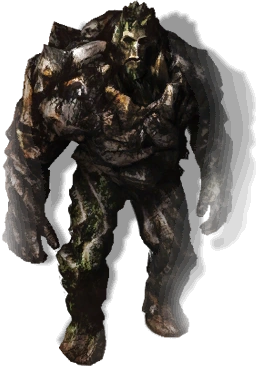

Golems / Elementals
There are two types of elementals in the game, but they are referred to as 'golems' in-game, and it's not until you read the bestiary entries for them that we get any sort of confirmation as to what they are. The first one, the Earth Elemental, is easily the more boring of the two, just being some dude made up of rock. Only one shows up in the game, guarding a bunch of treasure. Apparently the Earth Elemental is 'more mischievous', but rarely has a chance to show this side because it's summoned and bound to the will of its sorcerer master. And in the case of the earth elemental that Geralt meets, the order was to protect the treasure. Not much to say here, they're kind of boring.
The Fire Elemental, also know as the 'Golem' in game, is far more visually interesting. The Fire Elemental is a humanoid body seemingly made out of random chunks of wood bound together in a slipshod manner, giant spikes for a head, giant spikes for an arm, and, hell, even one of the legs is just a stump. I really love how unfinished this guy looks, with holes in its stomach. These show up a bit more often in Chapter 2 and 3, and the bindings around its 'head' sometimes glow depending on the location. These Fire Elementals are summoned by mages from its plane, and due to its alien mind, all it knows is to obey the orders its master calls it. It's really interesting that in this case the fire elemental isn't made out of fire, and I think it's implied that the sorcerer is binding the spirit of the elemental in this weird wooden golem bound by spell runes and stuff. Very cool-looking, I think the Fire Elemental/Golem is another one of my favourite enemies.
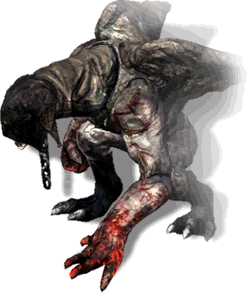
Gargoyle
The main monsters in Chapter 3 and briefly encountered in Chapter 2, the Gargoyles are... well, stone monster-men with long claws and wings. There's nothing particularly interesting about them, I feel, from a visual standpoint. They're what you expect a gargoyle to be, and while I do like that they have such a lumpy face, the most interesting thing about them is that the Gargoyles are, like Golems, bound to a sorcerer's spell. See, the gargoyles in the Witcher world are beings of stone brought to life, who are bound to certain rune-rooms in the abandoned mage city of Loc Muinne, guarding the abandoned chambers of their long-gone masters, and while Geralt can dispatch of the gargoyles relatively easily, he needs to get into the rune rooms and shut down the runes in the right order. It's a pretty interesting way to make the fight between Witcher and his prey a bit more complicated. Interestingly, while they are described as 'maybe a golem', Witcher 3 would classify them as an elemental (or, sorry, elementa) creature and in Witcher 2, they are able to teleport short distances and, well, as mentioned before, regenerate after death. Not a whole ton to say here.
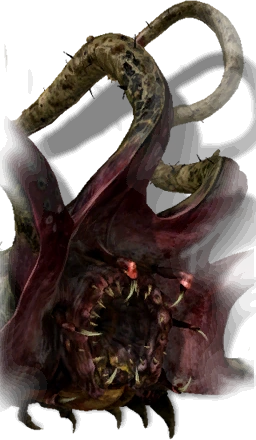
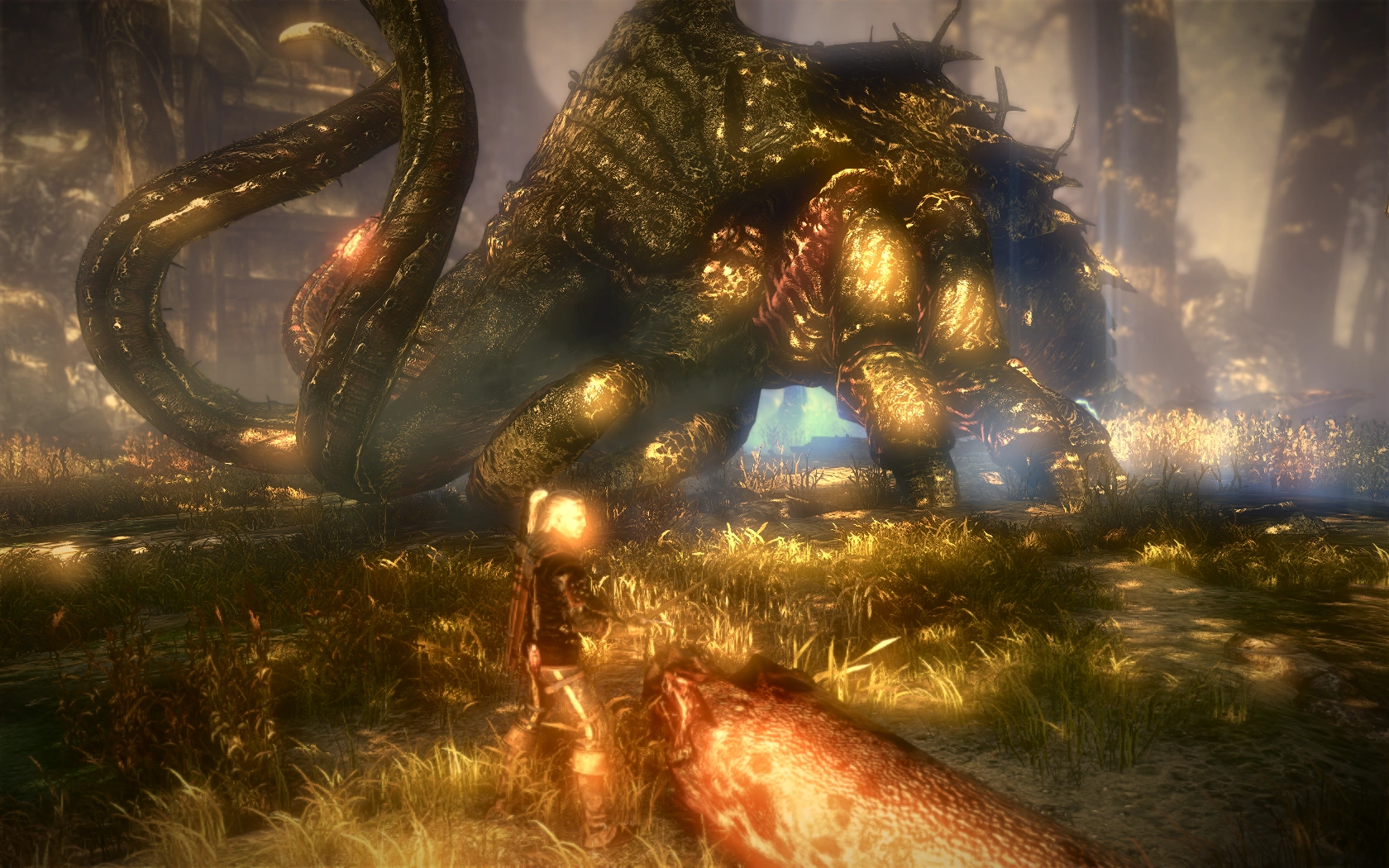
Kayran
The first act partially takes place in the swampy town of Flotsam, and you're quickly introduced to one of its largest threats, the Kayran. You first just see the giant tentacles and assume that it's this universe's answer to krakens, a giant boat-sinking octopus or squid. And... you're only half right. Sure, the anatomy of the Kayran resembles an octopus... kind of. When you finally manage to lure the Kayran out of the water, it's got the face of a giant octopus with ridges and stuff, but a massive maw that the Sarlacc would be proud off, and a bunch of powerful crab-like legs that allow it to scuttle around. The boss fight against him is essentially similar to a Zelda boss fight -- memorize attack pattern, trick it and slowly get rid of its tentacles one at a time. It's a pretty impressive giant boss fight and, obviously, I'm a huge fan!
It's got a bit of an interesting backstory, too, where not even Geralt's bestiary is quite sure of where the Kayran came from, only that it's a monstrous creature that somehow took up residence in the Pontar Valley's waters, and no one is quite sure if all of the tales of the Kayran attacking ship and shipyards are describing the same creature moving from shore to shore, or if it's just a seldom-seen species. It also dives underwater, where the technology of the time simply didn't have a way to deal with, and even when Geralt manages to draw it out of its lair with the aid of some lightning magic, he still has to craft a potion that makes him immune to the Kayran's poisonous membrane. A very cool giant boss.
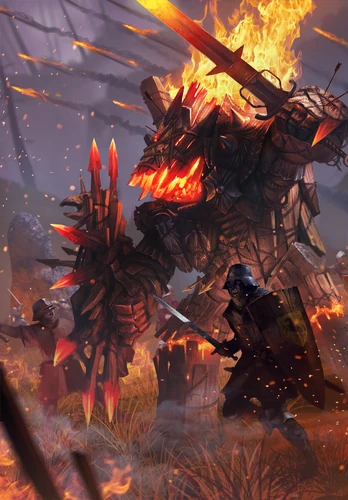
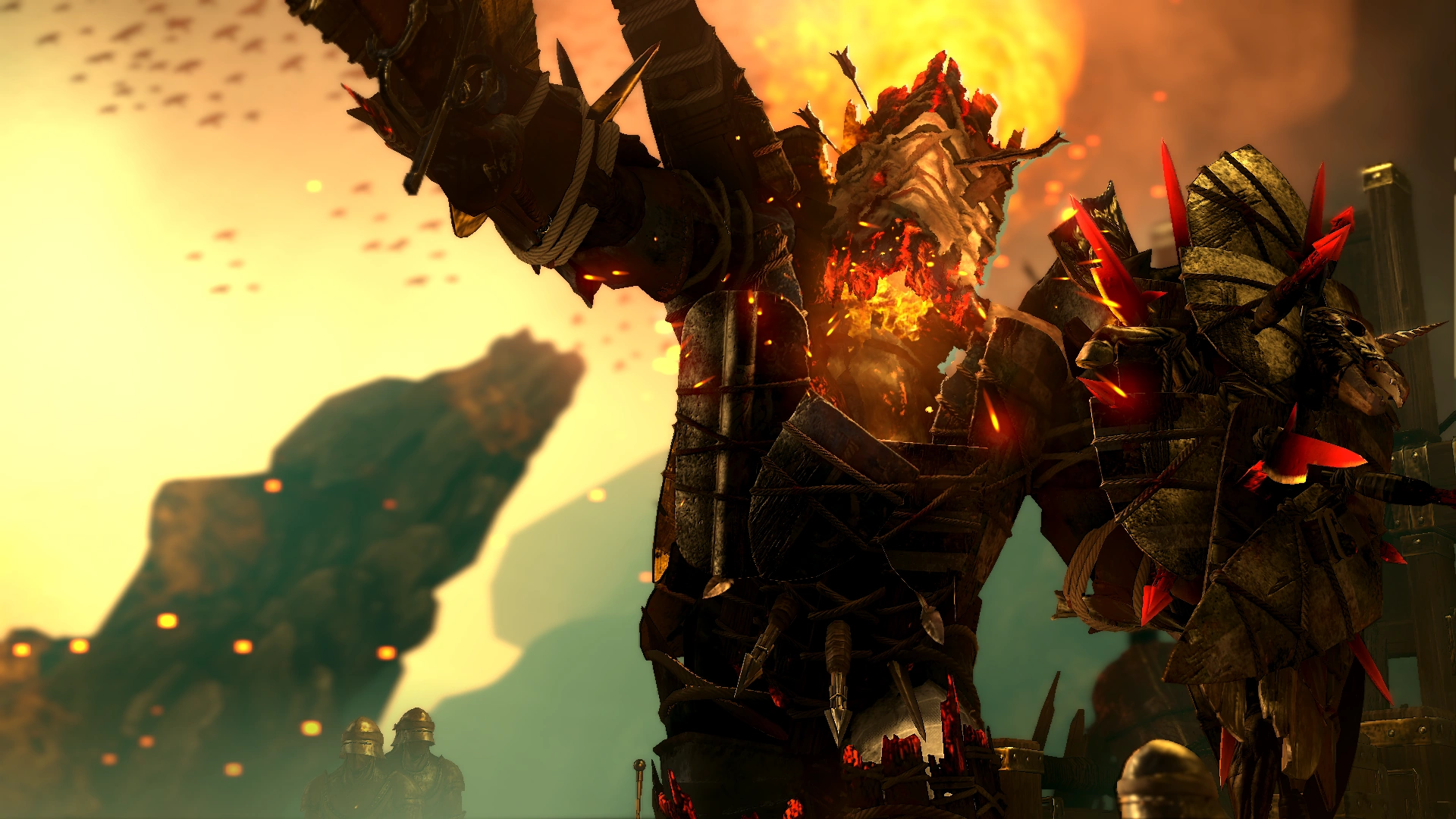
Draug
The second act's unique 'boss', so to speak, is the Draug, the boss of the Draugir. As mentioned above, Chapter 2 of Witcher 2 takes place on a reanimated battlefield, and one of the commanders of the battlefield is this massive walking furnace-demon made out of nothing but metal and flames called a Draug. It's hard to see from here, but its face is basically just a bunch of wood tied together and set ablaze, a very cool visual image. Apparently this is not the Draug's true form, but rather, what the spirit of one of the generals of Kaedwen manifests as the mighty Draug, reliving his final days in the battlefield. The bestiary notes how tales of the Draug are shrouded in myth, and all that's known about this 'Arch-Wraith' is that it's terrible, scary and undead. And normal mortals can't come to fight the Draug without 'getting on its level', which is to say to pass a bunch of trials or something to make the Draug susceptible to damage. In Geralt's case, he ends up having to figure out the circumstances behind the seeming betrayal of the sorceress Sabrina Glevissig that caused her to rain down death upon both her allies and enemies. The Draug itself isn't actually a powerful fight, but its design sure is neat.
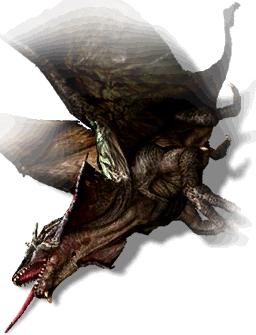
Dragon
The technical final boss of the game is Letho the Witcher of the Viper school, but since we're not going to review humans, the fight before him is Saesenthessis, the mind-controlled dragon.
You actually fight the dragon in the prologue segment of the game, although it's more of trying to escape being killed by the dragon more than fighting it. By the time you reach the end of the game, Saesenthessis is actually not that hard to fight. I picked Roche's path in my playthrough, but apparently you find out a lot more backstory about the dragon if you picked Iorveth's path (which is great and I won't spoil for anyone who hasn't played Witcher 2). Either way, a very cool fight scene and final boss even if design-wise Saesenthessis is... just a regular ol' dragon, and while certainly impressive it's not as unique as the Kayran, Arachas or Draug felt.
I do like the attempt to make Witcher 2's dragon feel unique, though, particularly with those weird little skin-flaps or mini-wings on Saesenthessis' neck, and the fact that this dragon has a body that's a bit shorter. I guess it's the game's way to try and make it look like an animal that can viably fly around. In Witcher-era, as told by the novels (and the Netflix show, which adapts the first two novels), the dragons are almost extinct. True dragons, that is, as Witcher 3 would show off a bunch of 'draconids'. The huge difference, of course, is that true dragons are sentient, intelligent and immortal, whereas draconids are just angry beasts that look like dragons.
I do like how the bestiary strikes a neat balance by portraying the dragons as this tragic sentient species that are hunted down to near extinction by humans as part of their reprisal and to claim trophies and alchemical ingredients... but they also note just how destructive most dragons are, being compared to cats that lounge about and don't care about what they destroys. Witcher 2's bestiary notes that there are five main types of dragons (white, black, red, green, rock) and a mythical golden one that's apparently able to shapeshift into humans and talk to them (this one shows up in the novels and the TV show). It's noted that most non-golden dragons are kind of like cats, who like to toy with their food. We really only meet Saesenthessis in Witcher 2, though, and at least for me, since I picked a different pathway, I didn't really see the full story and she's just a cool boss fight to me.
____________________
...And that's it for Witcher 2! I still have a long way to go before I finish the actual game of Witcher 3, and there's surprisingly a lot less monsters in this game than I thought there were. Still, the point of the game is less about showing the monster hunting parts and more about telling a story about Geralt and the politics of the land, so it really can't be helped. I do like the selection that we got for sure, though!

No comments:
Post a Comment